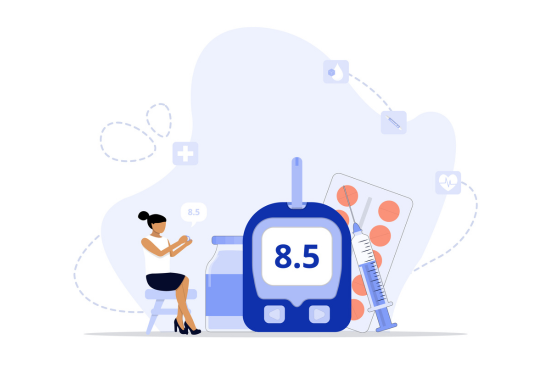Understanding Type 2 Diabetes: Causes, Symptoms, and Treatment Options

Understanding Blood Sugar Levels in Diabetes: Monitoring and Interpretation
19 Jun 2024
With diabetes, there must be so many questions that pop through your head. What is sugar? What is wrong with the sugar in my body? How do I handle it? What if something goes wrong? And so much more. On top of these scary questions is the fear of “Will I be able to manage diabetes by myself?”
Well, we’re here to tell you that you definitely can. It’s time to become an independent diabetic. But for that, knowledge of things is important. Hence, let’s understand diabetes blood sugar levels, how to monitor them, and the interpretations to be made after.
What are Blood Sugar Levels?
Blood sugar is the proportion of sugar in your blood. Every time there’s a fluctuation in your blood sugar levels, it helps determine how your body is dealing with diabetes, prediabetes, or related complications. Such fluctuations happen depending on what you consume throughout the day and how your lifestyle is. The impact of this is more prominent in diabetic people.
What is a Normal Blood Sugar Level?
A normal blood sugar level in your body means the content of glucose in your body is in the required proportion. It’s not overly high or overly low, but it is the right amount to help with proper energy production, brain functioning, and overall health.
The(fasting) blood glucose result of a person without diabetes is between 70 – 99 mg/dL.
What is a High Blood Sugar Level?
Having an excessive glucose proportion in your bloodstream may mean you have a high blood sugar level (Hyperglycemia).
What is a Low Blood Sugar Level?
Having a low blood sugar level means that the proportion of glucose in your body is lower than the normal blood sugar level (Hypoglycemia). It may also happen due to excessive insulin in the blood caused by skipping meals, medication, or physical activity.
It is usually found in Type 1 diabetes patients and Type 2 diabetes patients who are on medication.
Why is it important to monitor blood sugar levels?
For someone with diabetes, keeping a tab on their diabetes blood sugar levels is not just important, but it’s also a crucial part of helping yourself get better. It has to become a part of your lifestyle. Regulalrly monitoring your sugar levels can help you in several ways, like if you need more medication, what foods to eat, and how much you should exercise.
Regular check-ups enable you to understand the workings of your body well. Additionally, it also helps get rid of so many potential diabetes complications. Sometimes, complications can get as serious as affecting your feet or eyes as a result of too much sugar.
How do I monitor my blood sugar level?

There are several ways you can monitor your blood sugar level. Let’s understand what they are and the steps to use them.
- Blood Glucose Meter
A blood glucose meter, or glucometer, is a portable device used to measure the proportion of glucose in a small sample of blood.
Steps:
- Wash your hands with soap. Dry them well.
- Insert the test strip into the glucometer
- Use a lancet to prick the tip of your finger
- Squeeze out a small drop of blood
- Bring the tip of the strip into contact with the drop of blood
- Wait for the glucometer to display your glucose reading and record your results
- Continuous Glucose Monitoring (CGM)
The CGM method is where you wear a device that monitors your sugar levels all day. The sensor in the device helps in measuring your diabetes blood sugar levels. The device also helps form a graph later on that can show a summary of how your diabetes blood sugar levels keep changing and at what time.
Steps:
- Wear the device as per the manufacturer’s instructions and connect it to the transmitter
- Calibrate the CGM device as instructed
- View real-time glucose readings on your smartphone
- You can also set alerts for when your reading goes out of a normal range

-
Flash Glucose Monitoring
This is similar to a CGM, except they have sensors inserted under your skin to help measure the glucose levels constantly. Unlike a CGM, no real-time readings can be produced. The users have to scan the sensor with a reading device.
Steps:
- Check the instructions and insert the sensor
- Scan it with the reading device
- Record your readings
- Urine Testing:
It is a less common method and is only used in certain situations.
Steps:
- Obtain a urine sample from a clean container
- Dip a urine test strip in the sample urine and wait for some time
- Compare the colour of the strip with the urine colour chart to get an estimate of your blood sugar level
- Laboratory Testing
Like any other lab test, it involves giving your blood samples for a test in the clinical lab. Your doctor may ask for lab tests like fasting blood glucose and haemoglobin A1c, to check your overall blood sugar control.
How do I interpret my blood sugar readings?
It’s important to learn how to interpret your blood sugar readings correctly because it helps you with diabetes management. Let’s understand the art of interpretation:
- Normal Range (for most individuals without diabetes)
- Between 70 – 140 milligrams per deciliter (mg/dL) before meals
- Below 180 mg/dL after meals
- Low Blood Sugar (Hypoglycemia)
- Below 70 mg/dL (needs immediate attention)
- Symptoms: shakiness, sweating, dizziness, confusion, and irritability
- High Blood Sugar (Hyperglycemia)
- Above 180 mg/dL (should be addressed promptly to prevent complications)
- Symptoms: increased thirst, frequent urination, fatigue, and blurred vision
When interpreting your blood sugar readings, remember to as they can affect your glucose levels:
Time: Your glucose levels throughout the day change based on what you eat, physical activity, stress, and medicine.
Trends: Check patterns in your blood sugar readings over time. It can help you with your diabetes management plan.
Goals: Discuss with your doctor for seting target blood glucose ranges as per your age, health status, and treatment goals.
Other factors: Consider other factors like illness and lifestyle habits. Keep track of these and discuss them with your doctor to understand their impact on your diabetes management.
Conclusion
Easy peasy lemon squeezy, right? We told you so!
Now that you have gotten a better understanding of what diabetes blood sugar levels mean and the ways to monitor and interpret them, we hope your journey to diabetes management gets easier, at least slightly.
This is a battle you have to win and we truly believe that you can! To help you out, TatvaCare is your reliable personal assistant. Our GoodFlip app is an app designed to simply chronic care management for patients with diseases like diabetes. You can download our easy-to-use GoodFlip app on Android and Apple devices. It provides device integrations to help you track your vitals. You can also book diabetes tests through the app. We also provide personalised diet and exercise coaching to patients along with curated diabetes remission programmes. We aim to set realistic goals for patients to live a healthy and happy life. You can also watch this space for helpful content on health. For more information on TatvaCare’s products and services; raise queries; or leave a feedback, you can call us on +919974042363 or write to us at support@tatvacare.in.

Medically reviewed by
Dr. Devina Aswal 
MBBS, DDM, FCR, CIC
Recent Blog
- AI in Healthcare: Not a Threat, but a Smart Ally
- Your Clinic. Your Website. Your Brand.
- CDSS – Revolutionising Diagnosis with AI-Powered Clinical Decision Support System
- Handwritten to Digital in Seconds: SmartSync Converts Prescriptions Instantly
- Voice Rx by TatvaPractice: A Smarter Way to Digitise Prescriptions
Archives
Categories
- Asthma (20)
- Diabetes (15)
- Fatty Liver (20)
- High Blood Pressure (2)
- High cholesterol (2)
- Hypertension (2)
- Insulin Resistance (1)
- Obesity (8)
- PCOS (6)
- TatvaPractice (13)
Let’s Connect
Quick contact



